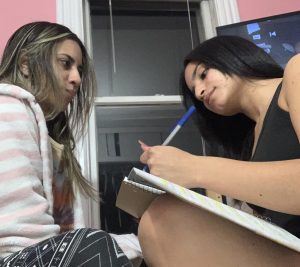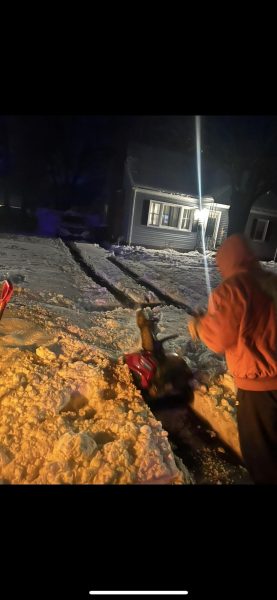A New Variant in Brazil Sends a Message to High Schools in the U.S.
With an average of 2,300 deaths per day, Brazil is becoming the new epicenter of the COVID-19 pandemic. Despite President Jair Bolsonaro’s promise to provide 46 million vaccine doses by the end of March, doctors are forced to turn away dying patients in favor of those with a higher chance of survival.
Silver Santos, a Brazilian citizen, alongside her 77-year-old mother, stands in line every day in hopes of getting a vaccine in the state of Rio de Janeiro. But every day , the clinic turns them away. There’s not enough vaccines. According to CNN, only 1.57% of the Brazilian population are fully vaccinated. Despite promising 46 million doses in March, the government lowered it to almost half by the end of the month. Due to this lack of supply, the vaccine campaign was put to a stop. “This is a disaster, a total disaster,” an anonymous woman told CNN. “Who is to blame for all [of] this? I think our leaders[…] our politicians suck.”

(Ananya Radhakrishnan)
Brazilian President Jair Bolsonaro is himself a COVID skeptic. In the past, he has publicly mocked the effectiveness of the vaccine and has yet to receive one. That same attitude of disregard reflected in the country’s citizens. In the buzzing streets of Rio de Janeiro, people still walk in proximity without masks. Although beaches closed, restaurants are still open until 9 p.m, a curfew President Bolsonaro enacted who, according to CNN, promised to never implement.
“[Bolsonaro] is one of those right-wing leaders who doesn’t really believe in the vaccines,” says Hall High School senior Sarah Goldman. “I think he buys into some of the conspiracy theories with the vaccine[,] which is a little bit scary because he’s leading an entire country. He should listen to [a valid science department].”

Hospitals are also hit hard. There are shortages of oxygen, medicine, and ventilators. But there is an essential resource in need of more attention: doctors. In the state of Bahia, 60 free beds were sealed off because there were not enough doctors to care for patients. With the influx of patients, intensive care workers feel overwhelmed and have had to refuse victims of other non-COVID related emergencies.
According to the Washington Post, ¾ of Brazilian state capitals’ critical care systems are occupied at over 90% capacity. With fewer places to take in and transfer patients, doctors have had to make life and death decisions, regardless of what their patients think. In February, a doctor in the northeastern state of Ceará, Diego Vieira had to choose between a young man in his 20s and a woman over 90. The hospital had room only for one. Because the younger man was more likely to live, Vieira saved him. “The problem was explaining the situation to the family,” Vieira said. “They threatened to sue me for leaving behind their mother to die.”
With survival of the fittest as the last resort, healthcare workers are subject to “mass trauma”. According to a Washington Post article, “researchers said more than half of respondents in Ceará state presented indications of mental illnesses, including anxiety, depression, insomnia, suicidal ideation and signs of post-traumatic stress disorder.” Without enough doctors and healthcare workers, who is to care for these patients?
Found in 21 out of 26 Brazilian states, a new variant is taking over the country. The variant, P.1, is found to be more contagious than the first and can even infect those who have recovered from the virus. Although scientists strive to conduct more research, limited resources hinder such progress. According to the New York Times magazine, “[w]hile the United States has done genetic sequencing on roughly one in 200 confirmed cases, Brazil sequences about one in 3,000.”
Moreover, other countries, especially the United States, are at risk for the new variant. “You can vaccinate your whole population and control the problem only for a short period if, in another place in the world, a new variant appears,” warns Ester Sabino, a University of São Paulo infectious disease researcher. “It will get there one day.” If P.1 does end up in the United States, high schools will shut down once again. Sarah Goldman notes her thoughts on a possibility of a resurgence of the virus: “I assume we would all go back to online learning which would be very difficult,” She said. “People already have a taste of what it was like to be at Hall so it would be really disappointing.”
However, many Hall students don’t know about the new variant at all. Goldman addresses this concern: “Sadly a lot of students don’t read the news on a regular basis so I don’t think most people know there’s a new variant,” She remarks. “Most people didn’t know there was a new one in Britain.”
With students unaware of the dangers still posed by the virus, many are choosing not to follow the safety precautions. Adir Barbosa, a Brazilian Hall parent, notes the only solution is “when people start to actually be serious about following the regulations like wearing a mask, practicing social distancing, avoiding parties, quarantin[ing] and always wash[ing] their hands.”
Goldman acclaims that she’s “definitely seen groups [of] more than that [10 people] on social media and other places.” Students have yet to grasp that even with most of the adult populus vaccinated, there are still consequences to not following standard COVID guidelines.
In terms of containing the virus in Brazil, there are solutions being presented even with the slow vaccine rollout.
UNICEF reports an estimate of “1,022,400 doses of [the] COVID-19 vaccine [will be sent to Brazil] through the COVAX mechanism, a global effort by the Coalition for Epidemic Preparedness Innovations (CEPI).” It’s the largest supply operation in global history. “This is a big step toward saving lives, stopping the spread of COVID-19, and getting back to the new normal,” says Socorro Gross, a World Health Organization (WHO) representative for Brazil.
The United States Center of Disease and Control Prevention (CDC) guidelines have protected the health of Americans. Their guidelines include covering your nose and mouth with a mask, socially distancing six feet away from others, avoiding crowds, and washing your hands regularly. These are ways to slow the spread of COVID-19.





